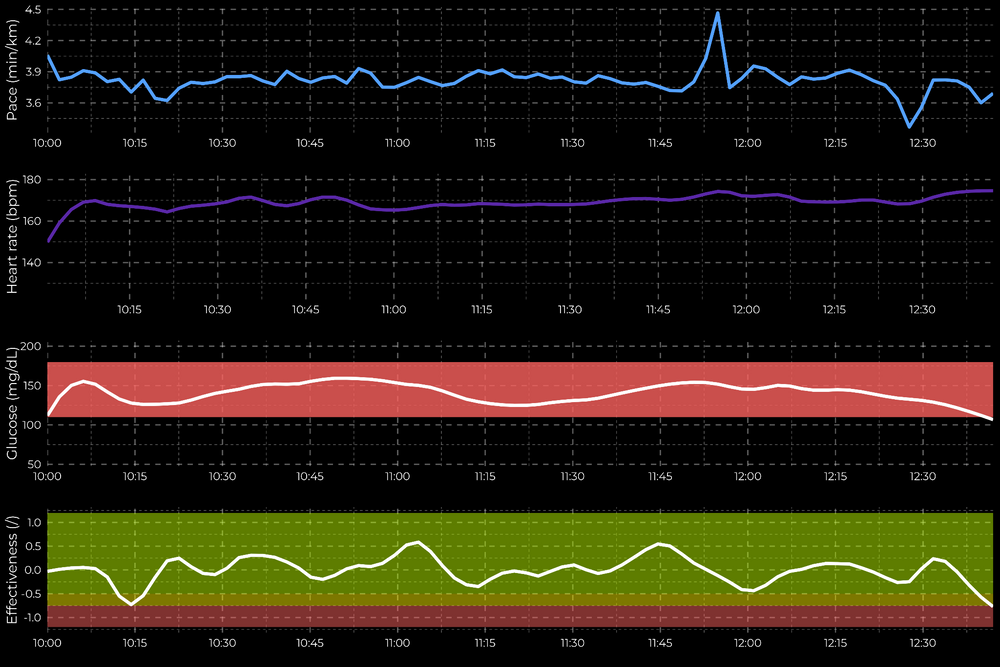Deep dive in to marathon fueling for 3 marathoners and how to evaluate your marathon fueling strategy.
Some of the team from Precision Fuel & Hydration and Supersapiens took on Spring marathons as part of the SuperPrecise Project.
The project was born out of the willingness for employees from both companies to apply the research they are reading and practice what they preach.
The companies often talk to each other and had been discussing the research around the format of carbohydrate intake (liquids vs gels for example). A group decided they were keen to do some testing on this using Precision Fuel & Hydration products and Supersapiens in preparation for the marathons.
Ultimately the team undertook a protocol designed by Supersapiens and in the beta testing phase of implementation. This involved testing various forms of carbohydrate (chews, gels and drink mix) from Precision Fuel & Hydration at the same doses, in similar conditions and for similar training sessions (long runs). By doing this the team started to note differences, if there were any and could help use this information to design their race day fueling strategies.
Research suggests that the form of carbohydrates does not have a significant impact in terms of performance and such the choice becomes largely based on personal preference and logistics. When it comes to road marathons and trying to run fast, gels are generally the choice for people and this case was no different given the team saw no significant differences in their glucose between the different trials.
With respect to fueling strategy, 60-90 grams an hour of carbohydrate is suggested for these sorts of efforts given their intensity and duration.
Whilst interstitial glucose measures as provided by Supersapiens needs no real introduction, “Glucose Effectiveness” is a much newer metric, still in development, and is likely new for most readers. In short; it looks at glucose kinematics in response to workload (in the case of running, usually heart rate is a good proxy) and looks at whether there is an appropriate glucose response to the fluctuations in the workload.
Values between -0.5 and 0.5 are considered appropriate responses, and values outside of this need some consideration (specifically values below -0.5). As is visible in the Glucose Effectiveness plots below, there is a yellow zone and then a red area where glucose is particularly concerning with respect to workload.
For a more in depth breakdown of Glucose Effectiveness (GE) see this piece.
The pace, heart rate, glucose and GE for the some of the team are displayed below, with some of the notable aspects of them discussed.
Chris "Minty" Harris
Interestingly, Minty never saw his glucose above 200mg/dL in training and had trialed periods of time with both race day intake and race day intensity. This speaks to the impact of a few factors that can increase glucose; metabolic stress as the marathon continues, adrenaline of race day and perhaps some psychological stress.
Ant
Ant had the dream marathon outside of an unplanned bathroom stop. True to form (this guy is fast), the bathroom stop didn't derail the marathon and was very swift. As a result no impact was really seen in his data.
Dave
Dave has a classic pattern of initial increase in glucose, this may have been an anticipatory response from the body which is not uncommon (including for Dave himself) or a result of increased intensity early on before settling into race pace.
As you can see all the team managed to keep their glucose in a good range and similarly you can see that they all had a good GE, meaning their glucose responded appropriately for their requirements. This was corroborated by both their performances (all ran PB’s) and subjective experience of their fueling. All of this, confirming their respective fueling strategies were appropriate (see above links to their respective case studies for more details on their individual strategies).
One quick note on heart rate for the team: the marathons (Manchester and London) were very flat and their pacing was very even. Minty ran a 2:40:52 with a 1:19:58 half way split, Dave ran a 2:42:13 with a 1:21:05 half way split and Ant ran a 2:30:10 with a 1:13:11 half way split (and second half pit stop).
As a result, heart rate was very consistent throughout and such changes in glucose are much more impactful in terms of GE than if heart rate was more variable and/or the course was more variable.
Take Home Messages:
-
Regardless of speed, making sure you plan your fueling and practice it in preparation for race day is key.
-
Use the guidelines as a starting point and adjust based on your comfort, performance, how you feel and glucose response during training.
-
Race day will likely mean higher glucose, this is normal with excitement and/or stress.
-
Don’t worry so much over the form you get your carbohydrates in (gels, liquids, bars etc), choose that based on logistics and preference.
-
Use multiple methods for evaluating your fueling strategy.
References:
Pfeiffer B, Stellingwerff T, Zaltas E, Jeukendrup AE. Oxidation of solid versus liquid CHO sources during exercise. Med Sci Sports Exerc. 2010 Nov;42(11):2030-7. doi: 10.1249/MSS.0b013e3181e0efc9. PMID: 20404762.
Jeukendrup A. A step towards personalized sports nutrition: carbohydrate intake during exercise. Sports Med. 2014 May;44 Suppl 1(Suppl 1):S25-33. doi: 10.1007/s40279-014-0148-z. PMID: 24791914; PMCID: PMC4008807.
The Highest Bar. Life Elevated. PureClean Performance



